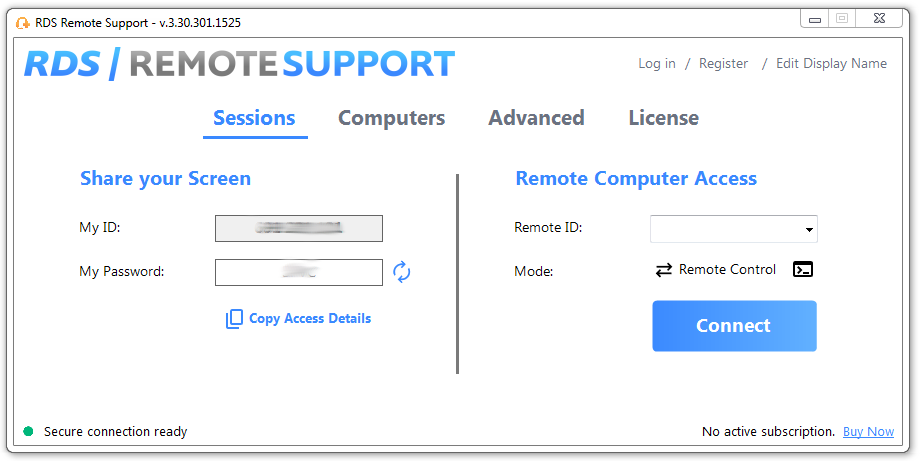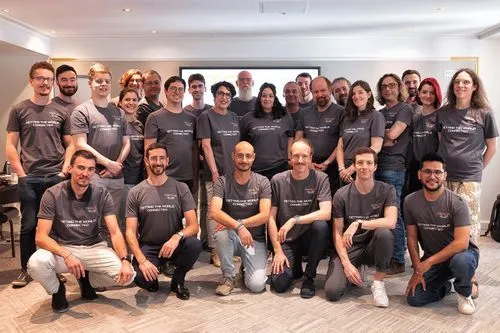"VDI vs RDP: A Practical Decision Framework (Costs, Risks & How To Supercharge RDS With or Without VDI)"
VDI vs RDP,: a practical decision making framework to examine costs, risks & requirements. Discover how to supercharge RDS with or without VDI.
Would you like to see the site in a different language?
RDS TOOLS BLOG
The ability to remotely access another computer over the internet has become a cornerstone of modern business practices, facilitating everything from remote work to IT support. However, as the reliance on remote desktop technologies grows, so does the potential for security vulnerabilities. This article will explore how you can securely connect to another computer over the internet knowing RDS Advanced Security is busy in the background ensuring your data remains protected from ever-evolving cyber threats.
)
Ours is a digital age, there is no denying this, and the ability to access a computer from a remote location is no longer simple convenience. Remote desktop access has indeed become a necessity for many businesses and individuals. It enables users to connect to a computer in another location through the internet, allowing them to interact with files, applications and resources as if they were physically present at the machine.
The core technology behind this functionality is the Remote Desktop Protocol (RDP), developed by Microsoft. RDP allows the transmission of display and input information between the remote user and the host computer. While RDP is built into most Windows operating systems, other protocols such as Virtual Network Computing (VNC) and independent software solutions also offer similar capabilities, providing flexibility across different platforms including Linux and macOS.
Remote desktop access is particularly valuable in scenarios such as telecommuting, where employees access their office computers from home or another remote location. It's also crucial in IT support, where technicians remotely connect to resolve issues without needing to travel physically. Furthermore, in education, instructors can access and manage lab computers or demonstrate software applications in real-time to students in various locations.
However, using remote desktop technologies continues to raise significant security concerns. Indeed, the connection between the remote user and the host computer can be a potential entry point for cyber threats if not properly secured. This risk highlights the importance of implementing robust security measures such as VPNs (Virtual Private Networks) which encrypt the data transmitted during the remote session, thereby safeguarding it against interception. Additionally, strong authentication and staff-team awareness remain paramount in any context.
Nevertheless, as the technology has evolved, so have the tools enhancing its security and functionality. For example, third-party solutions like RDS-Tools offer advanced features maximising the basic use of RDP functionality. Alongside RDS Tools Advanced Security, RDS-Tools provide improved encryption methods, multi-factor authentication for verifying user identities, as well as sophisticated monitoring capabilities able to detect and alert administrators of suspicious activities in real time.
The widespread adoption of remote desktop access technologies is a testament to their utility in interconnecting users around the Globe. As these technologies continue to develop, they present a powerful tool for businesses, offering not only increased flexibility and efficiency but also meeting the challenge of managing security in an ever-evolving digital landscape.
Through our deepened understanding of how remote desktop access works and recognition of the critical importance of secure setup and management, our teams worldwide can advise and guide your implementation. From Europe to India, the US to Eastern Asia, organizations can leverage RDS-Tools tools to facilitate secure seamless remote work environments while minimizing potential security risks. Partners and resellers benefit daily from the feedback, fixes and improvements this enables.
To effectively manage remote desktop access, IT professionals should focus on optimizing and securing their environments. Here’s how:
These advanced strategies ensure that remote desktop setups are secure, efficient and aligned with best practices in IT management.
When remote desktop access is enabled, especially over the internet, securing the connection against potential cyber threats is paramount. RDS Advanced Security offers robust features designed to protect your remote access environment effectively. Indeed, providing this robust layer of security addresses various vulnerabilities inherent to Remote Desktop Protocol. The software integrates seamlessly with existing authentication frameworks to ensure that unauthorized users cannot access the system even if they manage to compromise one form of identification.
Here are some of the standout features that IT professionals value most:
These features of RDS Advanced Security not only provide robust protection against external threats but also offer flexible tools which help administrators enforce security policies effectively. By implementing these advanced security measures, organizations can ensure that their remote desktop environments are both secure and compliant with regulatory requirements, providing peace of mind in a world of ever-evolving digital threats.
RDS Tools is a comprehensive set of tools designed to participate together in making RDS the best environment for secure, efficient use.
1. Multi-Factor Authentication (MFA):
One of the most effective security measures you can implement is Multi-Factor Authentication. MFA adds a critical second layer of security by requiring users to provide two or more verification factors to gain access to a remote desktop. This could be something they know (a password), something they have (a smartphone app) or something they are (biometric verification).
2. Continuous Monitoring and Alerts:
Continuous monitoring is crucial in detecting and responding to potential security threats in real-time. RDS Server Monitoring provides comprehensive monitoring capabilities that track user activities, login times and system changes during remote sessions. This monitoring helps in identifying unusual patterns that may indicate a security breach. Additionally, the system can send automated alerts to administrators when suspicious activity is detected, enabling swift action to mitigate risks. This feature is not only vital for maintaining security but also for complying with regulatory requirements that demand detailed access logs and incident reports.
3. Session Control and Role-Based Access Management:
Managing who can do what within a remote session is fundamental to securing remote desktop access. RDS Advanced Security allows administrators to define user roles with specific permissions and restricts what users can access and control during their sessions. This role-based access control (RBAC) helps prevent data leaks and unauthorized actions by limiting user access to the necessary resources for their role within the organization.
4. Anomaly Detection and Response:
Leveraging machine learning and behavioral analytics, RDS Advanced Security can detect anomalies in user behavior that might indicate compromised accounts or insider threats. Upon detecting suspicious behavior, the system can automatically take predefined actions such as logging the user out, limiting their access or alerting an administrator to investigate further.

RDS Remote Support Free Trial
Cost-effective Attended and Unattended Remote Assistance from/to macOS and Windows PCs.
Integrating these security features into your Remote Desktop access setup not only enhances protection against external threats but also helps in managing internal risks. By employing RDS Tools, businesses can ensure that their remote access capabilities are not a liability but a secure, efficient tool for facilitating remote work and IT management. This proactive approach to security is essential to face the sophistication and frequency of cyber-attacks which continue to rise.
While RDS Advanced Security significantly boosts RD connections, combining it with its fellow RDS-Tools product as well as best practice in cybersecurity can further reinforce the protection of your network and data. Here are essential guidelines to ensure that your Remote Desktop access remains secure against potential threats.
1. End-to-End Encryption:
To protect data in transit, RDS needs strong encryption protocols across the entire communication channel between the remote user and the host computer. End-to-end encryption ensures that any sensitive information exchanged during the remote session is incomprehensible to interceptors, thereby safeguarding confidentiality and integrity. By utilizing strong encryption standards, such as TLS (Transport Layer Security), you ensure that all remote sessions maintain the highest security level against eavesdropping and data breaches.
2. Use VPNs for Secure Connections:
A Virtual Private Network (VPN) adds an extra layer of security by creating a secure and encrypted connection between remote devices and your network. Though this setup can slow down communication, it not only encrypts all data transmission but also masks the IP addresses of the connecting devices. A VPN can therefore help protect against network sniffing and other types of cyber espionage. Implementing a VPN is particularly crucial when employees access the corporate network from public or unsecured Wi-Fi networks.
2. Keep Software Up-to-date:
Regular updates are vital in keeping the remote desktop software secure. Software updates often include patches for security vulnerabilities that have been discovered since the last iteration of the software was released. With Microsoft compatibilities this can be a particularly ongoing and precarious balance to uphold. Ensuring your Remote Desktop and other software are up-to-date mitigates the risk of cyberattacks exploiting known vulnerabilities.
3. Strong Password Policies and User Education:
Enforce strong password policies requiring users to create complex passwords which are difficult to guess. Passwords should be changed regularly, and users should be educated on the importance of not reusing passwords across multiple sites. Additionally, training employees on the basics of cybersecurity, such as recognizing phishing attempts and suspicious links, is essential in maintaining security.
4. Enable Firewalls and Intrusion Detection Systems:
Firewalls act as a barrier between your internal network and incoming traffic from external sources. They help to block malicious traffic and prevent unauthorized remote access. Similarly, intrusion detection systems (IDS) monitor network traffic for suspicious activity and can alert administrators to potential threats. Both of these systems are crucial for a comprehensive security strategy.
5. Regular Audits and Access Reviews:
Conduct regular security audits to check the integrity and effectiveness of your security measures. This includes reviewing who has access to what in the network and ensuring that only necessary permissions are granted. Removing access privileges from users who no longer need them or from old accounts which are no longer active can prevent unauthorized access.
By integrating these best practices with RDS Advanced Security and RDS-Tools as a whole, organizations from SMEs upwards can create a robust security environment, safeguarding their data and systems from both external and internal threats. This multi-layered pre-emptive approach to security ensures that the benefits of remote desktop access are realized without exposing the organization to unnecessary risks.
Remote desktop access offers unparalleled convenience and efficiency, enabling users to work seamlessly from any location. However, securing these connections is crucial to protect sensitive information and maintain operational integrity. By implementing RDS Advanced Security along with the best practices outlined in this guide, businesses can achieve robust security in their remote access setups. This proactive approach not only safeguards against potential cyber threats but also enhances compliance with data protection regulations, providing peace of mind in a dog-eat-dog business context.
Ready to enhance your remote desktop security? Explore RDS Advanced Security to discover how our solutions can protect your business operations. Contact our India or Worldwide support teams for a personalized consultation or download a trial today to see the difference for yourself. Stay secure and stay connected with RDS Tools.
Simple, Robust and Affordable Remote Access Solutions for IT professionals.
The Ultimate Toolbox to better Serve your Microsoft RDS Clients.
 Get in touch
Get in touch
